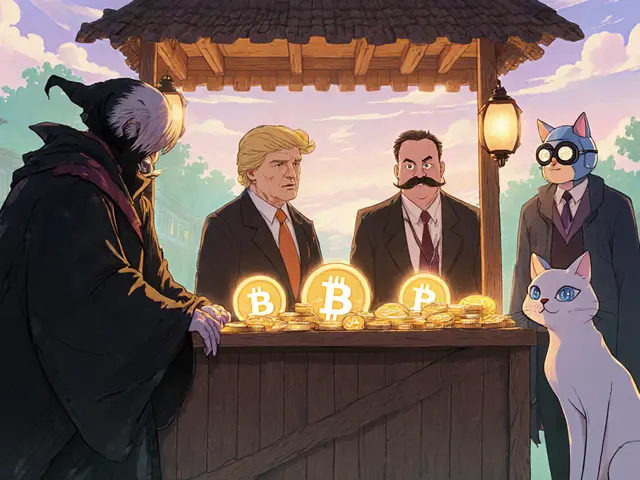8
Why India Leads Global Crypto Adoption Despite Heavy Taxation

India Crypto Tax Calculator
India applies a flat 30% tax on all virtual digital asset (VDA) gains, with 1% TDS on trades over ₹50,000 and 18% GST on platform fees since July 2025.
This calculator estimates your tax liability based on these rules.
Estimated Tax Breakdown
- 30% Flat Tax on Gains:
- 1% TDS on Qualifying Trades:
- 18% GST on Platform Fees:
- Total Estimated Tax Liability:
Note: These figures are estimates. Actual tax obligations may vary based on your specific circumstances and future policy changes.
Key Takeaways
- India ranks #1 in global cryptocurrency adoption even though it imposes a flat 30% tax on all digital‑asset gains.
- The tax structure adds a 1% TDS on trades over ₹50,000 and an 18% GST on platform fees.
- Adoption stays high because of a massive, tech‑savvy population, vibrant exchange ecosystem, and limited alternative investment avenues.
- Regulators are reviewing the framework, signaling possible relief in the next few years.
- Indian traders can stay compliant by using a structured tax‑record workflow and leveraging loss‑offset limits abroad.
When talking about crypto, India is a South Asian nation with a population exceeding 1.4billion, now leading global cryptocurrency adoption. The paradox is striking: a country that taxes digital gains at a flat 30%-the harshest among major economies-still tops the world in user volume, exchange activity, and on‑chain transactions. This article unpacks how the market thrives, what the tax rules look like, and where the policy debate is headed.
Cryptocurrency is a digitally native asset secured by cryptographic protocols, traded on decentralized or regulated platforms. In India, the government classifies these assets as Virtual Digital Asset (VDA) under Section 2(47A) of the Income Tax Act. The designation allows trading and investment but explicitly bars any use as legal tender. Multiple regulators share oversight: the Central Board of Direct Taxes (CBDT) drafts tax policy, the Income Tax Department enforces compliance, the Financial Intelligence Unit‑India (FIU‑IND) monitors AML risks, and the Reserve Bank of India (RBI) assesses systemic stability.
India’s Crypto Tax Regime in Detail
The backbone of the fiscal burden consists of three layers:
- Flat 30% tax on all VDA gains - treated like lottery winnings, with no allowance for loss set‑offs across assets.
- Tax Deducted at Source (TDS) of 1% on every transaction exceeding ₹50,000, deducted automatically by exchanges.
- From July2025, an Goods and Services Tax (GST) of 18% on all platform services, including trading fees, staking, and custodial charges.
Because the TDS is applied per‑trade, high‑frequency traders face immediate liquidity erosion even before filing returns. The GST adds a second‑order cost to every fee line, raising the effective price of using a platform. Combine these with the inability to deduct transaction‑related expenses, and the headline tax rate can feel closer to 50% for an active user.
Why Adoption Remains Sky‑High
Several forces outweigh the fiscal drag:
- Population scale - With over 600million internet users, even a modest participation rate translates into massive absolute volumes.
- Young, tech‑savvy demographic - Millennials and Gen‑Z in Tier‑1 cities view crypto as a gateway to global finance.
- Limited alternative investment products - Fixed‑deposit rates have fallen below 5%, prompting retail investors to hunt for higher yields.
- Robust domestic exchange ecosystem - Home‑grown platforms such as WazirX, CoinSwitch Kuber, and ZebPay have built localized onboarding, INR‑based fiat bridges, and KYC processes that lower entry barriers.
Even with an exodus of volume to offshore exchanges reported in industry surveys, the domestic market still commands a share of global on‑chain activity that outpaces the United States, Germany, and Japan combined.

Impact on Traders and Platforms
For an individual trader, compliance means juggling three separate reporting streams. First, every trade above ₹50,000 triggers a TDS deduction that must be reconciled in the annual return. Second, the 30% flat tax is calculated on the gross profit, with no offset for fees or mining costs. Third, the 18% GST on platform fees is collected by the exchange and reported to the tax authorities, appearing as an additional expense in the trader’s cash flow.
Crypto exchanges bear heavy administrative loads. They must register for GST irrespective of turnover, implement real‑time TDS deduction engines, and file detailed statements of each user’s taxable events. Failure to comply can trigger penalties exceeding 10% of the amount owed, plus interest.
These pressures have spurred a wave of innovation. Some platforms now offer “tax‑ready” statements, API integrations with accounting software, and automated loss‑tracking tools that help users calculate their net taxable position before filing.
How India Stacks Up Against Other Jurisdictions
| Country | Tax Rate on Gains | Loss Offset? | TDS / Withholding | GST / VAT on Fees |
|---|---|---|---|---|
| India | 30% flat | No | 1% TDS on ₹50k+ | 18% GST |
| United States | 0-20% (short‑term) / 0-15% (long‑term) | Yes, capital loss carry‑forward | None | Varies by state (typically 0-10%) |
| Germany | 0% after 1year; otherwise personal income tax rate | Yes | None | 19% VAT on services |
| Singapore | No capital gains tax | Not applicable | None | 7% GST on platform fees |
| Australia | 15-45% (as income) | Yes, limited | None | 10% GST on services |
The table makes it clear: India’s combined tax burden is among the steepest. Yet the country still outranks these peers in raw user numbers, underscoring the power of its demographic engine.
Policy Review and Future Outlook
In August2025, the CBDT launched a nation‑wide consultation, asking exchanges whether the 1% TDS and flat 30% rate are “excessive”. Early feedback points to three recurrent themes:
- Liquidity squeezes on high‑frequency traders.
- Migration of volume to offshore platforms that escape Indian withholding.
- Calls for a tiered capital‑gains model that mirrors traditional asset classes.
Stakeholders also suggest a “loss‑offset window” that would allow traders to deduct expenses like transaction fees, mining electricity, and staking rewards. If adopted, such reforms could reduce the effective tax rate by 10‑12 percentage points for active users.
While no formal amendment has been announced, the consultation signals a possible softening of the regime within the next 12‑18months. Internationally, many jurisdictions are moving toward clearer, innovation‑friendly rules, and India risks losing its talent pipeline if the tax climate remains punitive.
Practical Checklist for Indian Crypto Participants
- Maintain a detailed ledger of every trade, including timestamps, counterparties, and amounts in INR.
- Record the 1% TDS amount shown on your exchange statement; this will be reflected in Form26AS.
- Calculate gross profit per asset and apply the 30% flat rate; do NOT attempt to offset fees unless you have a separate business structure.
- Collect the GST‑inclusive invoice from your exchange for fee reimbursements; keep it for audit purposes.
- File ScheduleVDA in your annual ITR, declaring each VDA held at year‑end and the total turnover.
- Consider using an accountant familiar with crypto tax, especially if you trade across multiple exchanges.
Following this routine reduces the risk of a surprise tax demand and keeps you ready for any regulatory updates.

Frequently Asked Questions
Why does India tax crypto gains at 30%?
The flat rate was introduced in the 2022 budget to treat crypto like gambling winnings, simplifying tax administration and discouraging speculative bubbles.
Can I claim transaction fees or mining costs?
Under the current rules, only the cost of acquisition is deductible. Fees, mining electricity, and staking rewards cannot be offset against the 30% tax.
How does the 1% TDS affect my cash flow?
The exchange withholds 1% of the transaction value on each trade above ₹50,000. This amount appears as a credit in your Form26AS, but you must ensure sufficient liquidity to cover it before the trade settles.
Is the 18% GST applied to all crypto services?
Yes. Since July2025, every fee charged by a crypto exchange-trading, withdrawal, staking, custody-is subject to 18% GST, which the platform adds to the invoice.
Will the upcoming CBDT review change the tax rates?
The consultation is still ongoing. Industry feedback suggests a move toward a tiered capital‑gains model and the introduction of loss offsets, but no official proposal has been published yet.









Naomi Snelling
January 8, 2025 AT 07:55All this so‑called “adoption” is just a front for the state to monitor every transaction we make.
Michael Wilkinson
January 10, 2025 AT 07:55Look, the 30% flat tax plus the 1% TDS is a crushing load for traders, but you can’t pretend it’s a harmless fee; it directly slices your profit margins on every high‑value trade.
Billy Krzemien
January 12, 2025 AT 07:55For anyone just starting out, it really helps to keep a spreadsheet that logs the INR amount, the trade date, and the TDS deducted. That way, when you file your return, you won’t be scrambling for receipts.
april harper
January 14, 2025 AT 07:55One could argue that the paradox of massive adoption under heavy taxation mirrors the eternal conflict between freedom and control, a dance as old as civilization itself.
Clint Barnett
January 16, 2025 AT 07:55When you peel back the layers of India’s crypto surge, you see a tapestry woven from demographic momentum, economic necessity, and regulatory ambiguity.
First, the sheer population provides a massive pool of potential users; even a tiny fraction engaging with crypto translates into staggering volume.
Second, many young Indians view digital assets as a gateway to global markets, especially when traditional savings avenues yield meager returns.
Third, the domestic exchange ecosystem-platforms like WazirX and CoinSwitch-offers localized onboarding, INR fiat pairs, and KYC processes that lower friction.
Fourth, the 30% flat tax, while harsh, is applied uniformly, giving traders a clear rule of the road, albeit a steep one.
Fifth, the 1% TDS on high‑value trades acts like an automatic withholding, ensuring the tax authority sees a slice of every big move.
Sixth, the 18% GST on platform fees adds another cost layer, inflating the effective price of services.
Seventh, despite these levies, the alternative investment landscape in India remains limited, pushing savers toward higher‑risk assets.
Eighth, the government’s recent consultation signals a possible softening of the regime, providing hope for future relief.
Ninth, exchanges have responded by offering “tax‑ready” statements and API integrations that streamline reporting.
Tenth, many traders have begun using dedicated crypto accounting software to track gains, fees, and TDS credits in real time.
Eleventh, the lack of loss‑offset provisions means that every gain is taxed in full, which can feel like a double‑whammy when combined with GST.
Twelfth, some high‑frequency traders mitigate liquidity pressure by keeping a buffer for TDS deductions before trades settle.
Thirteenth, the tax framework, though heavy, creates a predictable environment that investors can plan around, unlike ad‑hoc policy swings.
Fourteenth, the cultural embrace of technology in India fuels a quick adoption curve, outpacing many developed economies.
Fifteenth, all these factors together explain why, despite the tax burden, India still leads the world in on‑chain activity and user counts.
Parker Dixon
January 18, 2025 AT 07:55Hey Michael, I get your point about the tax bite, but remember that many traders use the TDS as a pre‑payment toward their annual liability, which can actually smooth cash flow if you track it properly 😊.
Stefano Benny
January 20, 2025 AT 07:55Sure, pre‑payment is convenient, but the real issue is the hidden inefficiency: every 1% withheld on high‑frequency trades compounds, turning liquidity into a mirage. The system is designed to siphon off volume, not to help traders.
Bobby Ferew
January 22, 2025 AT 07:55Even with a crystal‑clear spreadsheet, the sheer weight of a 30% flat rate feels like an endless tax tunnel-no matter how neat your records are, the taxman gets his cut.
celester Johnson
January 24, 2025 AT 07:55That tunnel you speak of is precisely why the market keeps moving; traders adapt, innovate, and find ways around the drain, proving the resilience of the community.
Prince Chaudhary
January 26, 2025 AT 07:55Naomi, your suspicion is noted, but the data shows genuine user growth driven by economic factors rather than covert surveillance.
John Kinh
January 28, 2025 AT 07:55Yeah, keep it short-tax is a pain, but it’s real.
Mark Camden
January 30, 2025 AT 07:55While I appreciate the attempt to rationalize the system, let us not forget that tax policy should be grounded in fairness, not in the acceptance of an opaque framework that disproportionately burdens individual investors.
Evie View
February 1, 2025 AT 07:55Fairness? The reality is that most traders are just trying to survive; your moral lecture doesn’t change the fact that the 30% flat rate cuts deep.
Kate Roberge
February 3, 2025 AT 07:55Celester’s optimism sounds nice, but let’s be honest: the tax regime is a straight‑up profit‑eater, and no amount of “resilience” changes the math.
Oreoluwa Towoju
February 5, 2025 AT 07:55I’ve seen the numbers-adoption is huge, taxes are steep, but the market keeps growing.
Jason Brittin
February 7, 2025 AT 07:55Exactly, Oreoluwa, the hype never sleeps-traders keep moving, and the tax man keeps chasing. 🤷♂️
Amie Wilensky
February 9, 2025 AT 07:55One could argue that the entire narrative around “adoption despite taxation” is a constructed paradox, a self‑fulfilling prophecy fed by market sentiment rather than intrinsic utility.
MD Razu
February 11, 2025 AT 07:55The paradox you mention is indeed fascinating; however, beneath the surface, we observe a systematic pressure that forces participants to adopt sophisticated accounting practices, effectively professionalizing a retail hobby.
Charles Banks Jr.
February 13, 2025 AT 07:55Nice analysis, but let’s not pretend the tax isn’t a barrier; it’s the very reason many users are looking offshore for privacy and lower rates.
Ben Dwyer
February 15, 2025 AT 07:55Keep it simple-track your trades, file on time, and you’ll be fine.
Lindsay Miller
February 17, 2025 AT 07:55I understand it can feel overwhelming, but remember you’re not alone; many community groups share templates and tips to make compliance less stressful.
Katrinka Scribner
February 19, 2025 AT 07:55Tax stuff is a pain but hey, we got emojis now 😅👍.